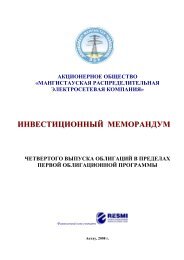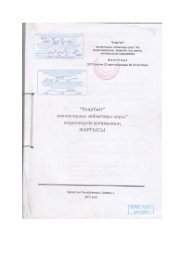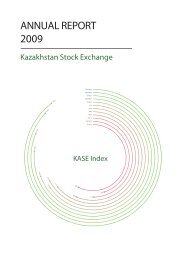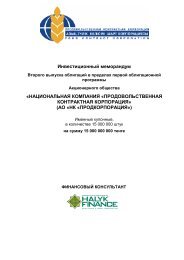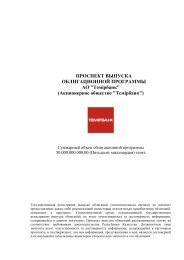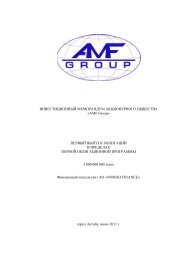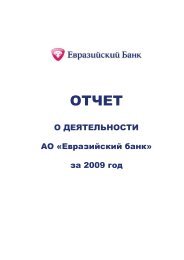JPMorgan - KASE
JPMorgan - KASE
JPMorgan - KASE
You also want an ePaper? Increase the reach of your titles
YUMPU automatically turns print PDFs into web optimized ePapers that Google loves.
The increase in FCA differentials primarily resulted from increases in transportation tariffs across<br />
the board.<br />
Downstream<br />
We acquired the Shymkent refinery on March 31, 2000 and, accordingly, the comparative<br />
numbers in the tables for 2000 include only the nine months following the date of acquisition.<br />
Due to the size of the available market for refined products in Kazakhstan, the refinery operated at<br />
51.5% capacity or 3,397,497 tonnes (approximately 26.3 MMbbls including tolling volumes) in 2001.<br />
The following table sets out the source of purchases and the movement in feedstock supplies for<br />
our refinery:<br />
2001 2000<br />
(MMbbls) (MMbbls)<br />
AcquiredfromHKM ................................................. 10.98 16.41<br />
Purchased from joint ventures (100%) ................................. 9.66 3.61<br />
Purchased from third parties ......................................... 0.59 1.05<br />
Totalfeedstockacquired ............................................. 21.23 21.07<br />
The following table sets out the source of inventory levels of feedstock:<br />
2001 2000<br />
(MMbbls) (MMbbls)<br />
Opening inventory of crude oil feedstock .............................. 0.08 0.19<br />
Purchase and acquisition of feedstock ................................. 21.23 21.07<br />
Recoverable feedstock from traps ..................................... 0.04 0.05<br />
Feedstock sold for export ............................................ (0.15) (9.58)<br />
Feedstock sold domestically .......................................... — (0.05)<br />
Feedstock refined into product ....................................... (20.86) (11.60)<br />
Closing inventory of feedstock ........................................ 0.34 0.08<br />
In addition to acquiring feedstock to refine into products, the refinery from time to time acquires<br />
refined product for resale. The following table sets out the movement in inventory of refined<br />
product:<br />
2001 2000<br />
(MMtonnes)* (MMtonnes)*<br />
Opening inventory of refined product ........................... 0.13 0.11<br />
Refined product from feedstock ................................ 2.55 1.46<br />
Refined product acquired ...................................... 0.09 0.15<br />
Refined product sold .......................................... (2.55) (1.54)<br />
Refined product internal use and yield losses ..................... (0.02) (0.05)<br />
Closing inventory of refined product ............................ 0.20 0.13<br />
* The inventory of products represents a mix of products for which no unique conversion from barrels to tonnes exists. The<br />
standard conversion used for crude oil by us is 7.746 Bbls to the tonne.<br />
The feedstock is refined into a number of products sold to derive the revenue from refined<br />
products. Refined product sales revenue for 2001 was $329.0 million and for the nine months of<br />
2000 the revenue was $203.7 million. The $125.2 million increase was attributable to the refinery<br />
producing more crude oil in 2001. The following table sets out products sold for 2001 and 2000,<br />
the average price achieved and the total refined products revenue:<br />
43




